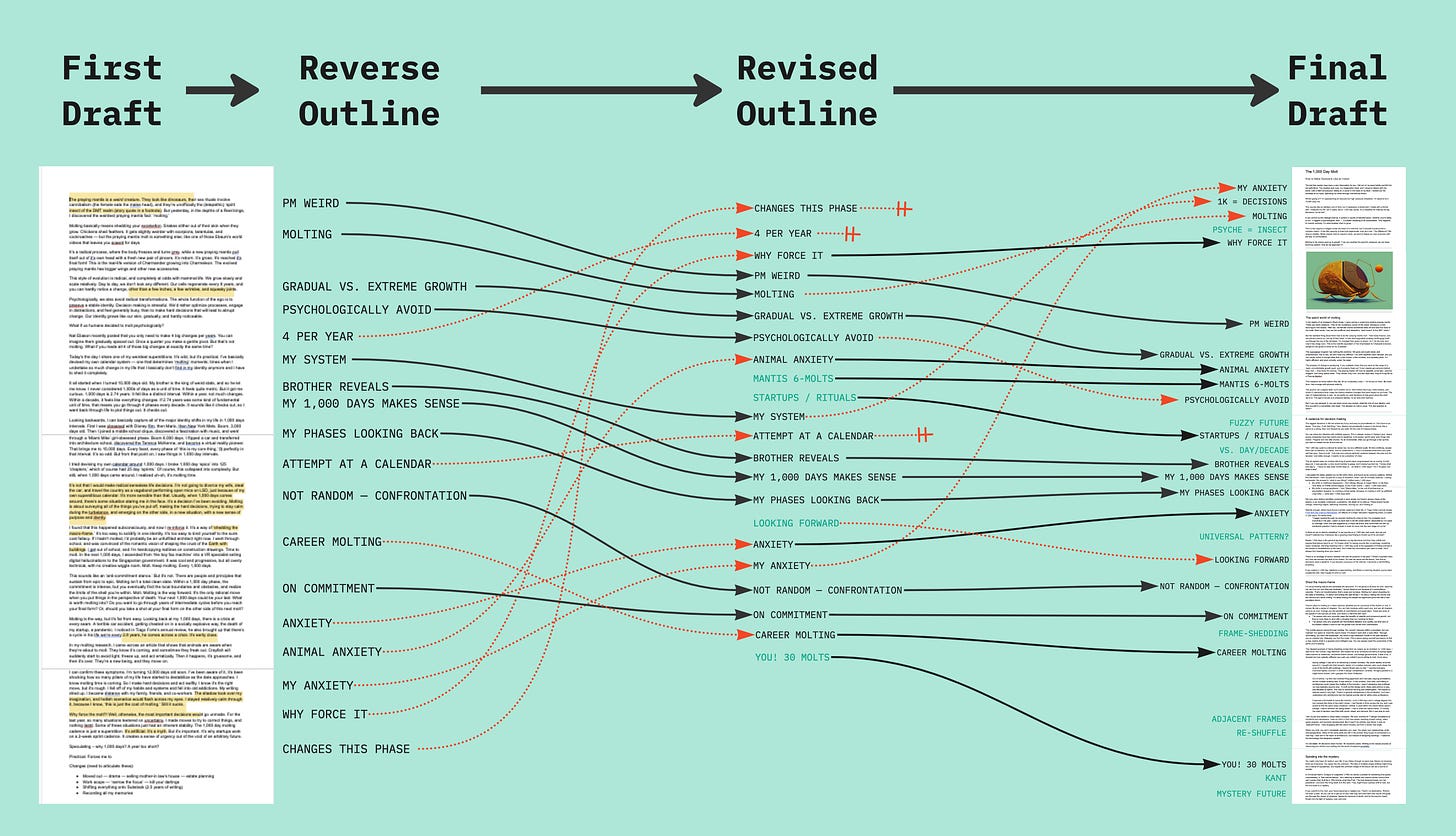Deconstructed #1
Reverse outlines, 93% rewritten, inline footnotes, two-column writing, and editing with your tongue. Lessons from “The 1,000 Day Molt.”
Hey again. My latest molt comes with a fresh publishing cadence too. This is a twice-a-week affair now. On Wednesdays I send essays; they’re evergreen ideas, properly tortured through editing razors. Saturday mornings are casual, and two things happen here:
First, I’ll share some quick updates. But then, for my fellow wordslingers, I’ll reverse engineer my latest essay. Today I’ll do a visual breakdown of the 5 lessons I learned from, “The 1,000 Day Molt: How to Make Decisions Like an Insect.” This feels like an honest (and personally useful) way to write about writing.1
But first, some updates.
Updates:
ALL MY THOUGHTS. The logs are moving to Substack! If you’ve never seen my logs, check them out here. Since December 2021, I’ve been uploading my notes-to-self onto my website. I write them in prose, so I get the dual benefit of remembering and practicing writing. I archive these each month, and recently learned how to set up a secondary “nav bar” on Substack using “home page links.” Feels like the web circa 2006. Check it out here. Little by little, I’ll migrate the old log archive over.
ONE WEEK IN 60 SECONDS. 2023 feels like the future. I chat with AI, my coffee mug heats itself2, and my glasses have cameras in them that record my memories. The hardware is made by Rayban, and the software is made by the devil3. Given my roots in VR, I was a willing guinea pig for this experiment. I’ll eventually explain how this all works, but for now, I want to know your reactions with no context. Here’s a video showing clips from the last 7 days, all recorded through my glasses.
Deconstructed:
This idea started as a note on a train, 7 days before I published it. I talked it out with 3 people, and wrote my first draft last Saturday; around 1,400 mediocre words in a 30-minute blitz. It underwent some restructuring and editing the next few mornings. I experimented with a few things on this one: inline footnotes, two-column writing, and editing out loud.
Here are the 5 takeaways from the process.
1. Reverse outline.
I usually aim to knock out a first draft in a rapid single-take4, so that I can “reverse outline” it. The next day, I compress every paragraph down to a simple title. It gives me an outline of what’s already on the page. By reducing 1,400 words down to 18 little “bits,” I can grasp the whole essay at once. It makes reconstructive surgery easy. I’ll shuffle text blocks into the revised outline, and then rewrite each paragraph.5
2. Editing is re-writing 93%.
The red text was deleted from my first draft, and the green text was added in the final draft. Those little spaces in between show what survived the edit (barely anything). Only 7% of words and phrases made it through. Given the final draft is 93% new, it shows me that my editing is about rewriting. A rewrite doesn’t always have to mean restarting from a blank page (though often it does). In this case, it’s about using a frozen blurt as a jump-off point. Thought is way easier to sculpt and refine when it’s externalized.6
3. Capture tangents in footnotes.
I wanted to test Substack’s new ‘inline footnotes’ feature. When you hover over a footnote in a desktop browser, it pops up over your mouse. No more scrolling down. I found this to be more than a nifty trick. It unlocks something in the creative process, and it’s kind of a paradox. It helped me both cut ruthlessly and add without restraint. My logical mind was empowered to cut anything that botched the linear flow of the piece. But also, my creative mind had permission to explode into divergent tangents, knowing they would find a home in a footnote. In the end, I published 1,018 words of footnotes, or 45% of the length of the essay.
4. Write with two columns.
I’ve been writing in Notion again the last few weeks. Composing in a two column layout is an unlock for editing. It lets you whip text left and right easily, and hide chunks of text within toggles. In a single-column vertical doc, there’s friction to cut and paste down to the bottom. It can take 5-10 seconds, which sounds innocent, but repeated over and over, can break your flow. I find it hard to use my editing sledgehammers in Google Docs. A two-column view lets me see both the canvas and the palette at the same time.
5. Edit with your tongue.
When the essay was done, I read it out loud one paragraph at a time. It was slow, and took over an hour. I’d loop a sentence over and over until I found a better way to say it, and then I’d put that on the page. When you edit with your tongue, you’re more likely to find rhymes, alliterations, and synonyms. Words shed their syllables, and mouthy sentences turn to butter.
Let’s riff:
Of the 5 points above, which ones landed with you? Are you going to try any of these? What can I clarify?
Feel free to comment with a link to something you wrote recently, along with a note on the process.
What are your reactions to the 1st-person video footage? I’m going to write an essay on this soon, so I want a pulse check on your first impressions.
Footnotes:
There’s a natural urge to triple down on content about writing and editing. It’s practical and valuable. It’s a nerve to pluck; my vector for audience growth. But if I were to only write about craft, I’d risk getting caught in “meta-limbo,” an endless circular loop of “writers writing about writers writing about..” The Wednesday <> Saturday cadence ensures that my thoughts on craft are informed by a real and evolving process.
I recommend the Ember mug with hesitancy. The problem is that it makes coffee too good. It’s always at peak temperature, and every sip is perfect. Naturally, the cravings increase, I drink more of it, and now my heart palpitations are back.
I couldn’t resist. Facebook’s ‘Metaverse’ efforts are easily taunted. The company obviously has a haunted past, and it’s easy to jump on the dunk train. But, I don’t think most of the bashers know the context behind the Reality Labs team, or the history of virtual reality. It’s complicated.
If you want technology-enabled vomit drafts, check out The Most Dangerous Writing App. If you stop writing, the text turns red and blurry. After any 5 second pause, the document ‘deletes’ itself. This induces real stress for a lot of writers, but it’s a seriously useful form of practice.
Here is a step-by-step guide on how I Reverse Outline. I’ll eventually make an essay out of this, but I wanted to share a detailed version in case anyone wants to try.











Hey, did you know your video with a playback speed of 0.25 is peak horror cinema? It's anxiety inducing but so good.
Point #2 resonated the most deeply. I too write everything out (or try to) in one giant inspiration filled burst. Then go back and chop it up, edit, and rewrite the whole thing. Wild to see the actual % that makes it through!
It’s also heartening to see other writers use this same process.
Here’s a link to my most recent piece:
https://startupsocial.substack.com/p/the-purpose-of-creativity
If you have 5 minutes to give it a read I’d really be honored.
—Zac